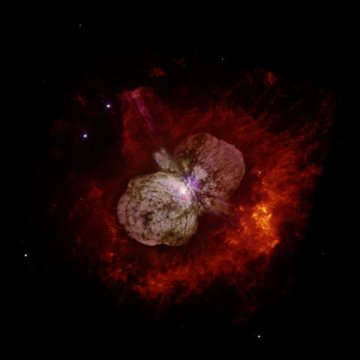The NuSTAR data measured between March 2014 and June 2016, together with the low-energy observations from the European Space Agency's Newton Space Telescope, showed that the X-ray measurements came from a source of colliding stellar winds at a temperature of over 40 million degrees Celsius. However, NuSTAR detected that the X-ray source emits over 30 electron volts, 3 times more than can be explained by shock waves from colliding stellar winds. For comparison, the energy of visible light ranges from 2 to 3 electron volts.

Eta Carina was known to astronomers as an unremarkable star until 1837. Then the star began to grow and brighten due to a large eruption that occurred in it. For a short time during 1843 it was the second brightest star in the sky before fading again.
A century later, in the 20s, it began to grow again, becoming a variable star when small fluctuations in its brightness were measured in a cycle of one to five and a half years. The big bang of the 19th century and the other changes in its brightness in recent decades are still a mystery to astrophysicists.
At the beginning of the 20th century, astronomers noticed that Eta Carina is a relatively large and dim object, and not a clean spot like a typical star. As the nebula spread and the telescopes improved, it became clear that it was a large cloud of dust and gas called the Homunculus Nebula, and it is shown here in the Hubble Space Telescope image, ejected during the great eruption of the 19th century and expanding outwards.
Now, the diameter of the nebula is about a light year. The expanding cloud contains enough material to form at least 10 objects the size of our Sun. Astronomers still can't (know) explain what caused this outburst.
A new study using data from NASA's NuSTAR space telescope shows that Eta Carina accelerates particles to high energies, some of which reach Earth in the form of cosmic rays.
"We know that cosmic ray particle bursts can reach almost the speed of light, and receive an energetic boost." says Kenji Hamaguchi, an astrophysicist at NASA's Goddard Space Flight Center in Maryland and lead researcher on the study. "Similar processes must occur in extreme environments, and our analysis showed that Eta Carina is one of those environments."
Astronomers know that cosmic rays with energies higher than a billion electron volts (eV) are constantly arriving from outside our solar system, but because these particles—electrons, protons, and atomic nuclei—all carry an electric charge, they are deflected from their orbits whenever they encounter magnetic fields. This incites their paths and masks their origin.
The Eta Carina system located about 7,500 light years in the direction of the southern constellation Carina was known for its eruption in the 19th century which made it the second brightest star in the sky for a short period of time. It is also surrounded by a nebula of material spreading outward as a result of the eruption but the cause of this eruption is only barely understood.
The system contains a pair of massive stars, one 90 times heavier than the Sun and the other 30 times heavier, orbiting each other in an elliptical orbit that brings them very close to each other - a distance of about 225 million km (close to the average distance of Mars' orbit around our Sun).
"The two stars that make up the Eta Carina system eject material in a process similar to our solar wind." says Michael Cochran, a member of the research team, also from Goddard. "When the collision direction of the winds of the two stars changes during the cycle, low-energy X-waves are created, and we have been tracking them for over two decades."
NASA's 'Fermi' space telescope observes sources of radiation in the gamma ray range - light with much higher energy than X-rays from the Eta Carina direction, but the astronomers could not confirm the connection between the observations of the two wavelengths. To bridge the gap between the low-energy X-ray and Fermi observations, Hamaguchi and his colleagues turned to NuSTAR. The NuSTAR space telescope, launched in 2012, can focus on much higher-energy X-rays than any previous telescope.
Using the new NuSTAR data measured between March 2014 and June 2016, along with the low-energy observations from the European Space Agency's Newton Space Telescope, it turned out that the X-ray measurements came from a source of colliding stellar winds, at a temperature of over 40 million degrees Celsius. However, NuSTAR detected that the X-ray source emits over 30 electron volts, 3 times more than can be explained by shock waves from colliding stellar winds. For comparison, the energy of visible light ranges from 2 to 3 electron volts.
The team members' analysis, published in the journal Nature Astronomy, shows that the intensity of the X-ray emissions changes in parallel with changes in the frequencies of other wavelengths depending on the orbital period of the two stars and show a pattern similar to that of the gamma rays measured by Fermi.
The researchers say that "the best explanation for the strong X-ray radiation and gamma emission is that electrons are accelerated by strong shock waves along the boundary between the stellar winds. The huge energy acceleration caused by the interactions of these electrons, some of them are accelerated to huge speeds, must escape from the system, and in the end some of them reach the Earth, here they are measured as cosmic rays."
"We've known for some time that the region around Eta Carina is a source of strong gamma-ray emissions," said Fiona Harrison, NuSTAR principal investigator and professor of astronomy at Caltech in Pasadena, California. "But until NuSTAR was able to locate the source of the radiation and show it was coming from a double star and study its properties in detail, the source was unclear."
